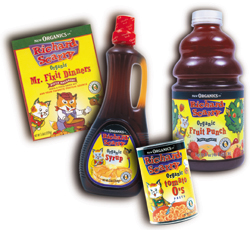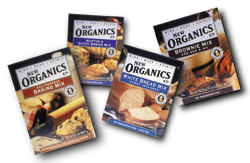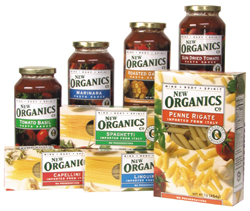
"We are a food company. We want to be able to cook our own products here, but more importantly, we want to be able to do our own research and development."
The New Organics Company has literally come a long way since its beginnings in Braintree, Mass., in 1997. Now headquartered in Long Beach, Calif., New Organics' offices have a total of roughly 9,000 square feet of space, with about 1,500 of that devoted to a fully operational test kitchen.
With more than
134 certified organic food products across 20 categories,
New Organics' items can be found in more than 4,000 stores
nationwide, including major chains like Albertson's, Kroger
and Safeway. Not content to rest on the laurels of a 1999
fiscal year that saw sales jump more than 40%, New Organics
in 2000 managed to forge a new category and a dominant place
in the organic foods industry.
Kids: Door Into Organics
Recognizing the lack of organic foods targeted at two- to eight-year-olds, New Organics developed a range of products specifically for that audience. The line needed an identifiable pull to children, though one that offered a positive message."Marrying up Richard Scarry with our New Organics food line made a lot of sense," says Chuck Monahan, vice president of sales and marketing. "Scarry started as an author/illustrator in 1969, and his message to children was always positive--stop-look-listen when crossing the street, how things work, and about the joy of reading. What he wrote was a positive message to children."
According to Paramount Pictures, some 82% of parents know of the Richard Scarry characters, but would that make a difference in the shopping aisles?
"We have found it really does make a difference," Monahan says. "When we call on buyers, when they have a knowledge of Richard Scarry (either because the books were read to them or because they read them to their kids), it is amazing how easily we will get approval and acceptance. The brand name has really helped dramatically in placing the product and getting it into distribution."
As fresh and innovative as the Scarry line may be, New Organics focused on more than just their children's products in 2000, debuting 21 items in its adult line as well. Now, with products as varied as baking mixes, barbecue sauce, condiments, dressings and soy sauce, New Organics can be found in a number of different categories, all part of the master plan which saw the company debut 27 new children's products and 21 New Organics items in one year.
"With the Scarry line, we were concerned that if we came out with just a few SKUs," says Zolezzi, "we would get lost in a sea of 40,000. Plus, we wanted to make sure we had a billboard effect coming out the door, because we do not get enough exposure in retail as it is. So, I think what really differentiates us is our nimbleness, quickness and ability to come out with not one or two but 27 products in the course of a year. Nine to 10 months from inception, we were ready to go to market.
"New Organics' mission has always been to be the organic solution for mainstream retailers and consumers. Industry changes have not materially changed our mission, but it certainly has changed our timetable. We need to move faster than ever to get organic food products into the hands of mainstream consumers and give them a positive experience. As a company we want to be responsive. We are dealing in such a small part of food--1% of the total food supply. When retailers say, 'Can you do a soy sauce or a barbecue sauce?' We have to react quickly and do it, because if we don't, someone else will."
All of New Organics' products are co-packed, and according to Mike Rubic, senior vice president of operations and business development, most of their production is done on contract, a situation that brings unexpected benefits.
"We really take an ownership philosophy with our manufacturers, inviting them into the R&D component and into our sales plans and projections. The manufacturers are key to this development. As they do contract work for many companies, they see what is going on in the industry, and that is very helpful. Inviting them into the process saves a lot of time and work and is an intelligent way to have a partnership, while not relying too heavily on outside consultants."
Currently, the
company has about 15 manufacturers producing for them and
also work with another five. Three New Organics employees
are dedicated to R&D, though that number can stretch to
15 when including developmental assistance from their manufacturers.
A Developing Situation
As Zolezzi notes, developing organically can have its challenges, but there are also areas where an organic alternative seems, well, natural--pasta sauces, salsas, tomato-based products, for example. The challenge can come in developing products where no organic alternatives exist."Once we identify a product, the challenge is how to get the same mouthfeel and taste with an organic formulation. For example, in baking mixes, we came out with a line of muffin mix, brownie mix, bread mix, pancake mix, all certified organic. The difference here? We have a more sophisticated person actually making the bread mix, with a specific expectation as it relates to taste and texture. In the children's line, a lot of that was uncharted territory. We did not know how to make an organic Mr. Fixit dinner, if it was feasible, what children or parents would think or if it would appeal to the children.
"In the New
Organics brand, the key is being able to identify categories
that make sense to convert to organic. In the children's line,
the challenge is coming up with products that kids will like."

The Taste is the Thing
New Organics strives to make the product taste as good if not better than their conventional counterpart and has found success in matching and even improving upon their competition. New Organics' pasta sauce, in fact, recently took home the American Tasting Institute's award of excellence for natural pasta sauces. As Zolezzi recalls, taste was the primary concern in developing, "because some of these products are difficult to produce organically with the equivalent taste of the conventional products."Developing the children's line appears to have been a particular challenge, as taste rides right along with another factor--color--in kids' eyes.
"With the Scarry line, the thing that really got me was, not only was it the taste, but color had just as much of an impact," Zolezzi explains. "If we did not have the right color, we never got to the taste part. For example, our macaroni and cheese does not have yellow dyes, so it is not as yellow. Interestingly enough, kids would not even taste it when it had that pale yellow color. Color has become increasingly important to children, at least in our experience. So we have really been challenged to come up with organic colors, or ways to color the products without artificial coloring--very, very challenging."
Other challenges have also plagued New Organics, most notably distribution. While "pretty much national," according to Zolezzi, the company's products just started penetrating the Midwest in the latter half of 2000, primarily with the Richard Scarry brand, though the New Organics line is increasingly finding its way onto shelves as well.
"That is probably
our biggest challenge," Rubic says, "getting the retailer
to have a look and see this is indeed an item that is moving
and needs to be kept in stock. Organic is new for a lot of retailers, especially a whole program like we have."

"The Richard Scarry line has really been a trailblazer for us in distribution," says Rubic. "It is different and appealing and is a whole program--not just one product. The line is a way for kids to have organic items throughout the day, but the key is really getting it out there, accepted and out on the shelf. Then it gets picked off the shelf, and it is a matter of making sure it is reordered and in stock. It is understandable that organic is not on everybody's radar screen, but it definitely will be."
Rubic believes those attempting to forecast the future of organics in the U.S. need look no further than the U.K. and Europe.
"In the U.K.,
growth is 35-40% in organic, whereas the U.S. is 20%. That
is driven by the retailers deciding to stock the product and
have a commitment to it in their stores. We are seeing that
more than ever before now in the U.S. We have tried to educate
and say, 'It is coming. Put them on the shelf. People will
buy them. Advertise. Let them know they are here. You can
bring in shoppers that drive to a natural foods store. If
you have the products on your shelf, and shoppers know they
are there, the consumers will be there. They will come back.'
We think that is what the retailers will see, and they are
going to stock more and build the whole category. So, I see
it really getting big. The keys here are consumer education,
availability and price."
The Price of the Cost
As Zolezzi notes, cost can indeed be a factor to consumers and can sometimes prevent the purchase of the organic alternative, but prices may be on the way down. "The more critical mass we get in volume, the more we will be able to drive down some distribution-related expenses associated with organics.""I think the price will come down," Rubic says. "I don't know if it will ever be on a par with conventional, but it will come down significantly, because there will just be more volume. As that happens, sourcing and costing comes down. It is starting to happen in the U.K. and Europe now. If it reflects on the shelf price in the store, it will accelerate this sector. If it does not, I still think it is going to accelerate but probably not as fast."
For New Organics, the future holds more development, more products and wider acceptance.
The company has the capability to introduce another 20+ products under the New Organics brand, according to Monahan. For these new products, the demographics and market research have already been done, but New Organics wanted to concentrate sales efforts on their current lineup. The New Organics brand, which is at about 60 now, could expand to 100, he estimates. "Likewise, Richard Scarry could go easily to 100+ products under that brand name and do fine."
Rubic sees a promising future for the New Organics Company, a future that holds more than just New Organics' food items.
"New Organics' mission is to be the leader in the whole organic supply chain and is involved in many other facets outside of food for organic. We are certainly focused on the New Organics brand, but we are also focusing on the private label area. Retailers are asking New Organics to come in because we have a lot of SKUs, more than most companies, at least on shelf-stable items, and they are asking for the ability for private label."PF
